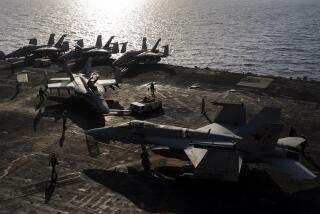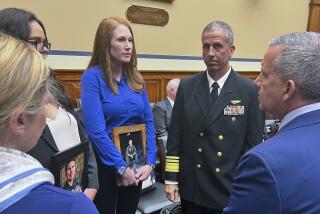Navy Won’t Ground Fleet of CH-53Es
- Share via
Navy Secretary John F. Lehman Jr. on Friday refused a congressman’s request to ground the Marine Corps’ fleet of accident-plagued CH-53E Super Stallions, saying that the helicopter has been operating under restrictions that will “maintain safe flight operations.”
In a statement circulated to some congressional offices in Washington, Lehman said the new flight restrictions, which he did not disclose, were put into effect as a result of investigations and engineering reviews by the Naval Air Systems Command and the Navy Inspector General.
Letter Not Mentioned
Lehman’s statement did not mention a letter sent to him last week by Rep. Robert E. Badham (R-Newport Beach). In that letter, Badham, a member of the House House Armed Services Committee, called for the grounding of the entire fleet of CH-53Es because of a possible “inherent design deficiency.”
“It doesn’t do what I wanted it to do,” Badham said of Lehman’s statement.
Badham, who until very recently has been a staunch supporter of the Marines and the Super Stallion program, said Lehman’s remarks show the Navy “is just screwing around trying to calm the situation down.”
He vowed to have Lehman or one of his representatives before the House Armed Services Committee in the coming week to explain the Navy’s stance. “We want to get this on the record,” Badham said.
Though he stopped short of accusing the Navy of a cover-up, Badham said during a press conference last week that the Navy has known about the helicopters’ possible structural problems for more than l0 years. But Navy officials, he said, chose to ignore them and continued to fly the $24-million aircraft. He said in an interview earlier this week that after talking to high-ranking Marine officers he is convinced that the Navy never told them of the Super Stallion problems.
United Press International quoted an unnamed Navy source who said Lehman’s decision to require flight restrictions was not a response to Badham’s letter but resulted from a review conducted by the Navy Inspector General that began in May.
“That’s hogwash,” Badham said.
Called for Probe
He said the Navy would not have asked for the investigation last spring if he hadn’t first called for a congressional probe into the CH-53E. “And he (Lehman) would not have had a statement today if I had not written him a letter.”
Lehman’s statement said the “engineering deficiencies identified over the last year” will be modified in all new models produced by Sikorsky Aircraft of Stratford, Conn., which has provided the Navy and Marines with hundreds of the CH-53s, including the earlier 53A and 53D Sea Stallion models.
“All such changes will be incorporated into new aircraft production and backfitted into existing aircraft,” Lehman’s statement said.”
Cmdr. Mark Neuhart, a spokesman for Lehman, said the CH-53E is allowed to operate under a weight restriction, and Lehman’s order makes that limitation more strict.
“The Inspector General has recommended that additional flight restrictions be imposed to ensure safe flight operations,” Neuhart told UPI.
Lehman’s public information officer did not return numerous telephone calls from The Times Friday.
The Associated Press reported that the new limits generally involve the type of maneuvers that pilots may fly and procedures to be followed over certain types of terrain.
Some Confusion
Some congressional staffers found Lehman’s statement Friday confusing.
“I have been studying the statement with a staffer from the Armed Services Committee, and I don’t know what it means,” said one congressional staffer. “It is not clear whether the restrictions, whatever they are, are new or have been in place for some time. Whatever, the statement is toothless.”
The worldwide fleet of 92 Marine and Navy Super Stallions has been involved in a string of accidents that have claimed the lives of more than 20 Marines and injured another l7. In the latest crash on Jan. 8, five Marines were killed when their CH-53E slammed to the desert floor during a routine training mission near the Salton Sea in Imperial County.
The Navy since has temporarily grounded all CH-53Es because of a gearbox problem that was discovered at the Sikorsky Aircraft plant on Feb. 12. The fleet was grounded two days later and has not flown since.
The CH-53E, the military’s biggest and most expensive helicopter, is designed to carry up to 55 fully equipped combat troops. The helicopter, powered by three big General Electric turbo jets, can lift up to 32,000 pounds of cargo.
More to Read
Sign up for Essential California
The most important California stories and recommendations in your inbox every morning.
You may occasionally receive promotional content from the Los Angeles Times.










